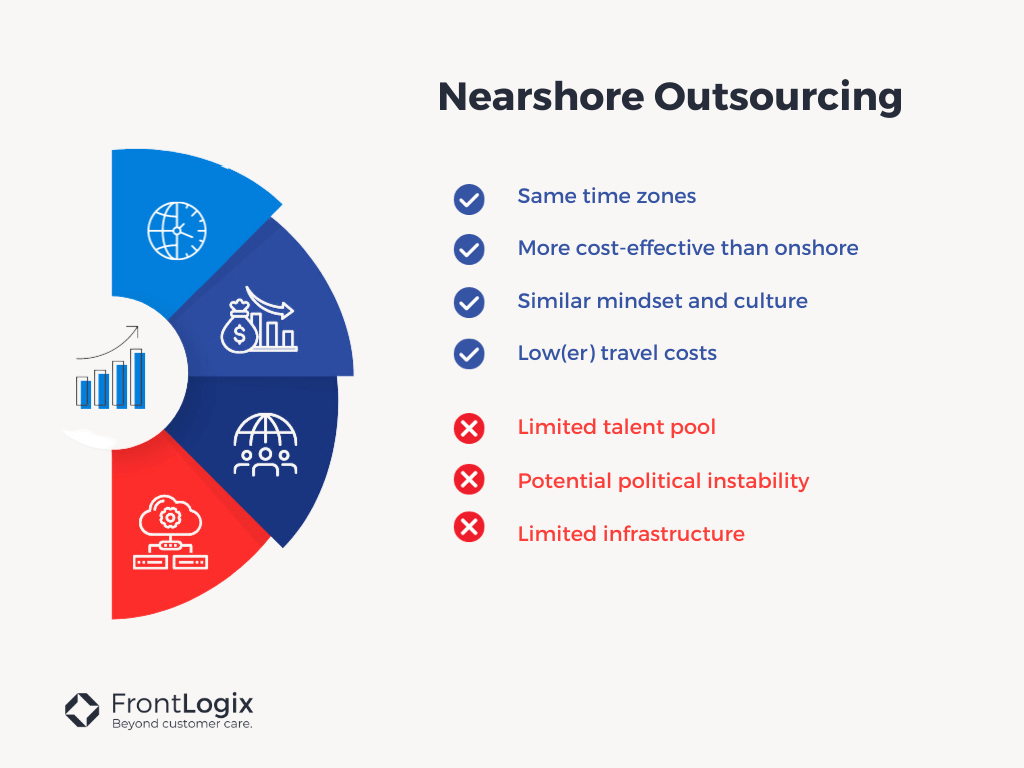Is AI taking over contact centers?
We already know how fast technology is developing. And no day goes by without hearing something about AI (Artificial Intelligence). But AI is not just a buzzword. It actually helps businesses find new ways to connect with their customers. With all this innovation and new tools, one question keeps coming up: Is AI taking over contact centers?
The short answer is no. AI isn’t replacing human agents. Instead, it’s transforming how contact centers operate by automating repetitive tasks, providing real-time insights, and enabling businesses to deliver faster, smarter, and more personalized customer experiences. FrontLogix is embracing this change by combining advanced artificial intelligence with the invaluable human touch.
Is AI taking over contact centers? Here, we explore the impact of artificial intelligence on contact centers, including why human agents remain essential for customer support. This blog post also highlights how FrontLogix is helping businesses navigate and succeed in this era of innovation. It’s getting interesting, so keep reading.

STRATEGY GUIDE
CX Trends for 2025:
AI, hyper-personalization, and the future of CX—are we ready?
AI, hyper-personalization, and human-centered design are taking center stage—but not without their challenges.
Are you prepared for the risks they bring? Unpack the trends!

The Rise of AI in Contact Centers
Let’s face it: AI has been a hot topic in customer service for years now. From chatbots that pop up on websites to voice assistants that help route your calls, AI has become an integral part of how businesses interact with their customers. But despite its growing presence, there’s still a lot of confusion about what AI can and can’t do. Is AI taking over contact centers?
Read more on the nine critical areas where AI falls short and human expertise excels.
It goes without saying that some people worry AI will replace human agents entirely. But the truth is far more nuanced. Rather than taking over, AI is stepping in to handle repetitive tasks and provide support behind the scenes so that human agents can focus on what they do best: solving complex problems and building meaningful connections with customers.
This is where FrontLogix comes in. By leveraging advanced AI tools and strategies, FrontLogix helps businesses strike the perfect balance between automation and human interaction. The result? Happier customers, more efficient operations, and empowered employees.

How is AI transforming your contact center?
- Automating Routine Tasks
AI-powered chatbots and virtual assistants handle repetitive tasks like answering FAQs, booking appointments, or troubleshooting common issues. This automation allows businesses to provide 24/7 support while freeing up human agents for more critical responsibilities.
- Enhancing Personalization
By analyzing customer data and past interactions, AI enables personalized support tailored to individual needs. This creates a more satisfying experience for customers while fostering loyalty.
- Intelligent Call Routing
Traditional IVR systems often frustrate customers with endless menus. AI changes this by using natural language processing (NLP) and sentiment analysis to understand caller intent and route them to the right agent or self-service option.
- Real-Time Agent Assistance
During live interactions, AI provides agents with real-time suggestions and insights, empowering them to resolve issues faster and more effectively.
- Predictive Analytics
Is AI taking over contact centers? AI doesn’t just react, it predicts. By analyzing historical data, it forecasts call volumes, peak hours, and customer preferences, helping businesses allocate resources more efficiently.

The Human Touch: Still Irreplaceable
While AI has revolutionized many aspects of contact centers, there’s one thing it can’t replicate: the human touch. At FrontLogix, we understand that no matter how advanced technology becomes, people still crave authentic, empathetic connections, especially in moments of frustration or uncertainty. Is AI taking over contact centers? That’s why our approach emphasizes the irreplaceable value of human agents, ensuring they remain at the heart of customer service.
Complex Problem Solving
AI is fantastic at handling routine tasks and providing quick answers, but when it comes to intricate or unique problems, nothing beats human creativity and critical thinking. Is AI taking over contact centers? Human agents excel in situations where there’s no clear-cut solution, whether it’s troubleshooting a technical issue that doesn’t fit a script or navigating a complex billing dispute. These scenarios require empathy, adaptability, and the ability to think outside the box, skills only humans possess.
Building Emotional Connections
Customer service isn’t just about resolving issues—it’s about building relationships. When customers are upset, frustrated, or dealing with sensitive situations, they want to feel heard and understood. Is AI taking over contact centers? Human agents bring emotional intelligence to the table, offering reassurance and empathy in ways that AI simply can’t replicate.
For example, imagine a customer calling about a lost package containing a sentimental item. While an AI system might provide tracking updates or suggest filing a claim, a human agent can go further—acknowledging the emotional significance of the situation and offering personalized support. These moments of genuine connection leave lasting impressions and turn one-time customers into loyal advocates.
Personalized Care That Goes Beyond Data
Is AI taking over contact centers? AI excels at analyzing data to deliver personalized recommendations, but human agents take personalization to another level by adding context and intuition. They can pick up on subtle cues—like tone of voice or unspoken concerns—that machines might miss. This ability allows agents to tailor their responses in real-time, creating experiences that feel truly customized.
At FrontLogix, we ensure our agents have access to AI-powered insights while retaining the flexibility to adapt their approach based on each customer’s unique needs. This combination of technology and humanity ensures every interaction feels personal and meaningful.

THE ULTIMATE GUIDE ON
HOW TO PROVIDE WHITE-GLOVE CX
What you will find inside:
✔ The history of white-glove service: Origins and significance of personalized care.
✔ The white-glove experience today: What your customers expect from you.
✔ Why white-glove CX is not the norm: Challenges to delivering this level of care.
✔ Five white-glove service tips: Practical ways to provide top-tier service.

Turning Challenges Into Opportunities
One of the most remarkable traits of human agents is their ability to turn even negative experiences into opportunities for growth. A skilled agent can de-escalate tense situations, rebuild trust, and leave customers feeling valued, even after a mistake or misunderstanding. Is AI taking over contact centers? These moments of recovery are critical for maintaining brand reputation and fostering loyalty. At FrontLogix, we believe that while AI is an incredible tool for enhancing efficiency and streamlining processes, the human touch makes customer service truly exceptional. By empowering our agents with cutting-edge technology and emphasizing empathy, creativity, and connection, we ensure every customer interaction leaves a positive impact.
FrontLogix: The Future of AI-Enabled Customer Service
At FrontLogix, we believe that the future of customer service lies in the augmenting of AI technologies with human expertise. Our mission is to empower businesses to deliver faster, more personalized, and highly efficient white-glove Customer Experience. Is AI taking over contact centers? By leveraging cutting-edge AI tools, we not only transform contact centers into hubs of innovation but also ensure that the human connection remains at the heart of every interaction.
AI in Service of the Human Connection
FrontLogix prioritizes a technology-enabled, human-driven approach. While our AI-powered solutions handle routine tasks—such as answering FAQs, scheduling appointments, and managing live chats—our human agents focus on more complex customer interactions that require empathy, creativity, and emotional intelligence. Is AI taking over contact centers? This balance ensures that customers receive the best of both worlds: efficiency from AI and personalized care from trained professionals.

Innovative AI Solutions by FrontLogix
- AI-Powered Virtual Agents
Is AI taking over contact centers? Our virtual agents are designed to streamline operations by managing repetitive inquiries and providing instant responses. This allows human agents to dedicate their time to high-value tasks, improving overall productivity and customer satisfaction.
- Real-Time Assistance for Agents
FrontLogix’s AI tools provide real-time coaching and guidance during calls, offering agents insights into pricing, competitor information, and de-escalation tactics. This ensures that every response is accurate and tailored to the customer’s needs while boosting agent confidence and reducing turnover.
- Intelligent Call Handling
With features like real-time call transcription and sentiment analysis, our intelligent call-handling systems ensure that customers are routed to the right agent or self-service option quickly. This reduces wait times and enhances first-contact resolution rates.
- AI-Driven Workforce Management
Using advanced scheduling models powered by historical data and predictive analytics, we help businesses anticipate demand fluctuations and allocate resources effectively. This proactive approach minimizes inefficiencies while maintaining exceptional service quality.
- AI-Enabled Quality Assurance
Is AI taking over contact centers? FrontLogix uses AI to monitor interactions, assess performance, and deliver actionable insights for continuous improvement. This ensures that service standards remain consistently high across all channels.
Conclusion: FrontLogix – Your Strategic Partner in AI-Driven Customer Service Excellence
As we navigate the rapidly evolving world of customer service, one thing is clear: the future belongs to businesses that can seamlessly integrate advanced technology with the human touch. Is AI taking over contact centers? AI is no longer just a tool, it’s a transformative force that’s reshaping how contact centers operate, empowering teams, and enhancing customer experiences. Is AI taking over contact centers? But even as AI takes center stage, the value of human empathy, creativity, and connection remains irreplaceable.

GUIDE
8 Contact Center Challenges and How To Solve Them
In this guide, we list the eight most prevalent contact center challenges and useful solutions for addressing each one.

At FrontLogix, we’re embracing this change by combining cutting-edge AI solution implementation with human-driven strategies. We help businesses create smarter, more efficient contact centers that deliver exceptional results. Is AI taking over contact centers?Whether it’s through automating routine tasks, providing real-time agent assistance, or enabling hyper-personalized customer interactions, our approach ensures that technology serves to enhance (not replace) the human element.
Is AI taking over contact centers? Whether you’re looking to enhance efficiency, improve customer satisfaction, or future-proof your contact center, FrontLogix offers tailored solutions and sophisticated tools that meet your unique needs. With a focus on innovation, workforce empowerment, and exceptional customer care, FrontLogix ensures that your business is ready to exceed expectations in this era of rapid technological advancement.
Is AI taking over contact centers? The future of contact centers isn’t about choosing between humans and AI. It’s about leveraging the strengths of both to create extraordinary customer experiences. With FrontLogix by your side, you’ll have the tools, expertise, and support needed to lead the way in modern customer service.

Found this useful?
Subscribe to our newsletter and get CX and WFM news delivered to your inbox.
Don’t worry, we won’t flood your inbox – just one insightful email a month!










































